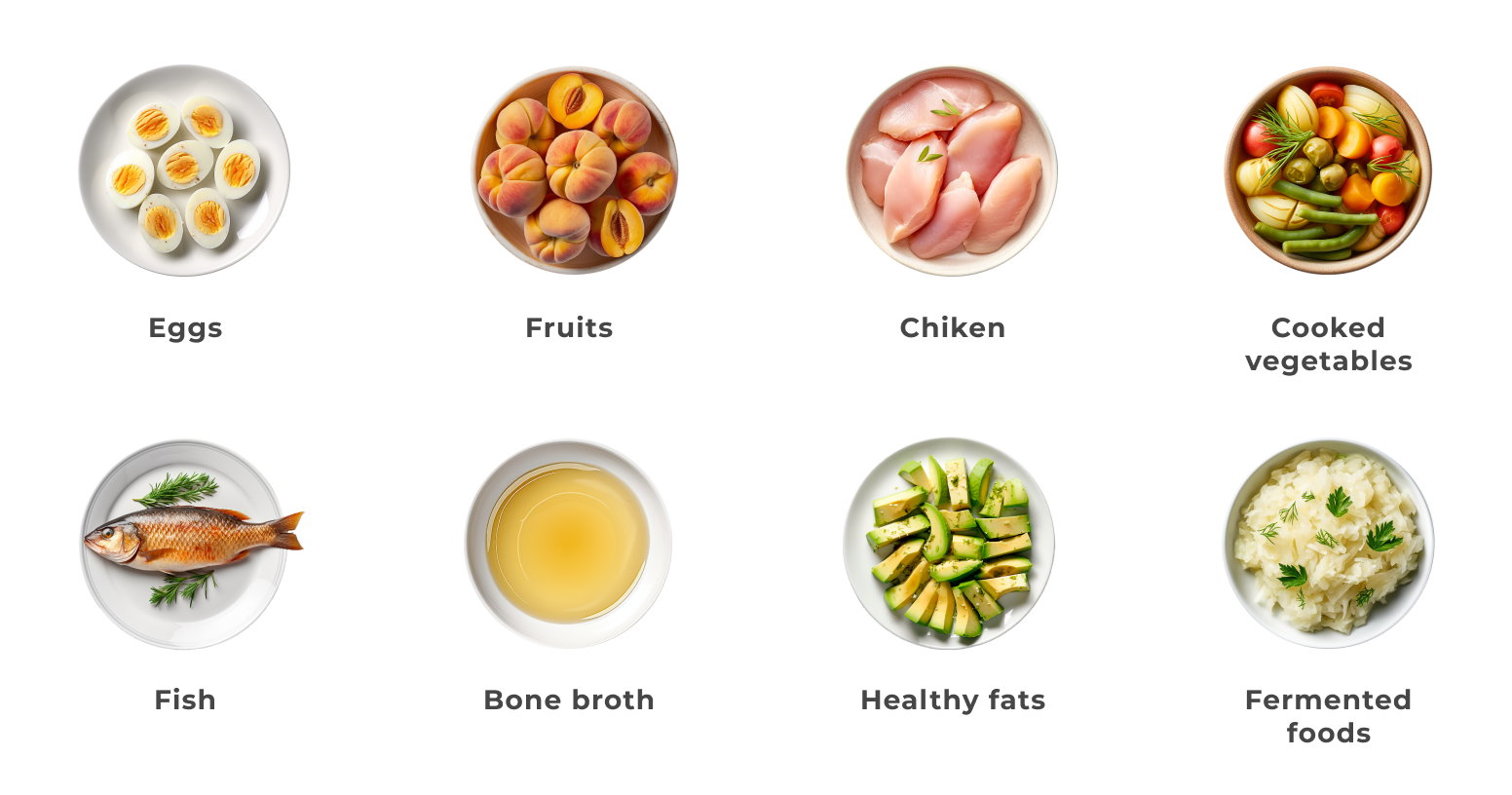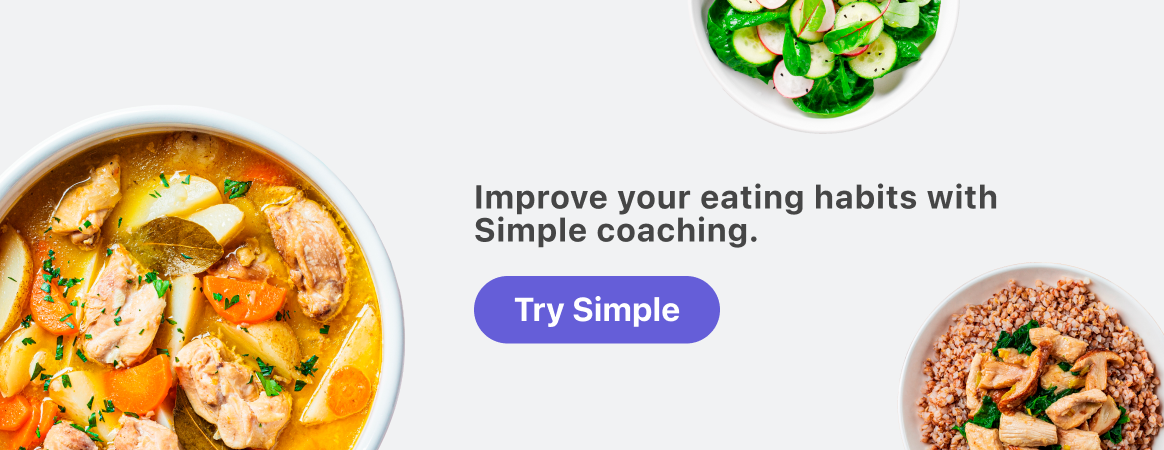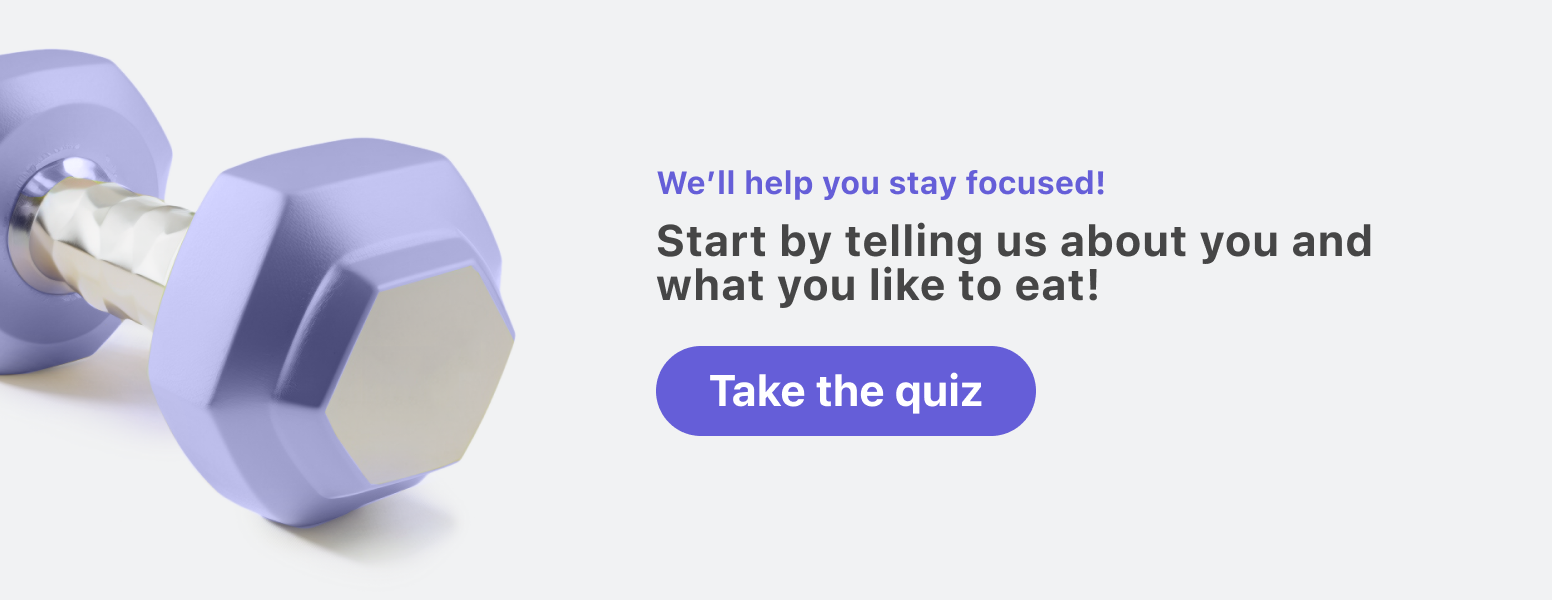The best foods to break intermittent fasting

You made it through your fasting window — congratulations!
Whether time flew or you had to grit your teeth through a few hunger pains, you crossed the finish line.
… Now what? Is any food fair game, or do you need to ease your body back into eating?

Here’s everything you need to know about how to break a fast and the best foods to break intermittent fasting.
Breaking a fast — what is it?
Understanding what breaking a fast actually means starts with understanding how fasting works. (For a longer backstory, check out our intermittent fasting for beginners guide.)
If you haven’t eaten for twelve hours, your levels of insulin (a hormone that transports sugar from your blood to your cells) have dropped, and your body has started the process of lipolysis (breaking down fat cells to use as fuel).[1] Once you’ve been fasting for 12 to 18 hours, you’ve then likely reached ketosis (a metabolic state where your body starts burning fat as energy).[2]
In other words, you’re in a fasted state.
The idea of “breaking” something may sound like a big, complicated affair, but in this case, it simply means eating enough calories to push your body out of this fat-burning fasted state.
Whether that push is more like a nudge that keeps you moving or a hard shove that knocks you over comes down to what you eat.
One of the best aspects of an intermittent fasting schedule is the flexibility; there aren’t any foods you need to avoid completely, and you don’t need to count calories either. That said, there are some foods you may want to save for later in your eating window and some foods you may want to eat more of for maximum health benefits.
We always recommend consulting your healthcare provider before making any changes to your eating routine, but if you’ve been cleared for the intermittent fasting train, we’re here to help you board, have a comfortable journey, and stay on track to reach your destination. Take our Simple quiz to unlock your first-class fasting experience.
Foods that won’t break your fast

Before we get into the best food to break a fast and what to eat after a fast, let’s look at what you can eat during a fast that won’t break it.
We get a lot of questions around what breaks a fast, and a lot of them involve what you can drink while fasting, like:
- “Will lemon water break a fast?”;
- “Can you drink tea while fasting?”; and
- “Does coffee break a fast?”
(Remember that magical time when you didn’t realize liquid could contain calories? RIP, blissful sipping ignorance.)
While technically speaking — in terms of the dictionary definition of “fasting” — any calories in any form will break a fast, a few calories during a fasting window won’t completely knock your body off course. Scientific evidence hasn’t come to a hard-and-fast conclusion on this topic, but it’s anecdotally accepted that up to ten calories during a fast is totally okay.
That means things like water with fruit in it, coffee / tea with a teaspoon or two of milk, or a berry or two won’t snap you out of your fasted state or make you miss out on any fasting benefits.
The process of breaking a fast may also look different depending on why you’re fasting. There are no universal set rules for success here; that’s why having a clear idea of your fasting goals and getting your healthcare team involved is so important.
Supplements
If you’re eating nutrient-dense, health-promoting foods during your eating windows — such as fruits, vegetables, lean proteins (like eggs, fish, or tofu), and grains (like quinoa) — it’s unlikely you’ll need to take supplements or vitamins while fasting, but if you’re worried you’re not hitting your ideal nutritional levels, supplementation may help.[3]
Some supplements are absorbed better on an empty stomach, while others are more effective when taken with food, but when you take a supplement should be about what feels most comfortable for your body.
Some supplements may also break a fast (they’re not all low-calorie), so if you’re taking one during a fasting window, check for calories or added sugar. Common calorie-containing supplements include things like protein powders, electrolyte drinks, amino acids, collagen, and gummy vitamins.
For a full run-down of options and considerations, check out our guide on fasting supplements. And don’t forget to consult your healthcare provider before taking any supplements.
Best foods to break an intermittent fasting diet

Ultimately, what to eat during intermittent fasting comes down to your needs, goals, and preferences — there’s no set menu, and you can substitute ingredients and switch up recipes to your personal tastes.
As a general rule, though, the best way to break a fast is to avoid immediately flooding your system with sugar or hard-to-digest nutrients, which can spike your insulin levels or cause digestive discomfort.[4,5] You also want to aim for a nutrient-dense meal that offers your body a balance of the key macronutrients it needs (protein, carbs, and healthy fats).
While an extended fast (beyond a day or two) requires a bit more finesse to ease back into eating without stressing your system, we don’t recommend fasts longer than 18 hours without medical supervision.
So, although what and when you eat is entirely up to you, here are our suggestions for the best foods to break intermittent fasting if you want to power up your fasting benefits and avoid missing out on important nutrients.
Eggs
Eggs are one of the best foods to break a fast — and a particularly great choice for your first meal, as observed in this study on a group of men.[6] They’re naturally high not only in protein but also in various vitamins, minerals, and antioxidants.[7] They may also benefit gut health without causing any digestive inflammation or discomfort, as seen again in another study on men.[8] Plus, as far as uses go, they’re super versatile — you can make them the star of your meal every day for a month and still not run into recipe overlap!
Fruits
Fruits are basically health-promoting superstars. In addition to being filled with vitamins, minerals, antioxidants, and water, they also contain fiber to promote fullness and benefit digestion and gut health.[9] The majority of fruits are also low in sugar, and what sugar they do have is natural (which doesn’t impact health or spike your blood sugar in the same way as added sugars). Any fruit goes — so pick your favorites; plus, you can add some Greek yogurt for a protein kick!
Cooked vegetables
Standing on the superstar stage next to fruits are vegetables, which are just as densely packed with nutrients and health-benefiting compounds. Leafy veggies like spinach and kale and starchy veggies like squash, sweet potatoes, and peas are especially high in fiber, so we specify “cooked” here because cooking softens the fiber content to make it more palatable to your rested digestive system (without sacrificing all the vitamins, minerals, and antioxidants!). If you have a sensitive stomach, try starting with cooked carrots, bell peppers, and zucchini, and gradually include other varieties over time.
Chicken
If you’re looking to break your fast with animal-based protein, chicken has three major things going for it: it’s lean, it’s easy to digest, and it lends itself to things like soup, which can be easier to stomach (literally!) than a big hunk of meat. It’s also great that chicken is full of health-promoting nutrients that promote fullness and help restore energy post-fast.[10]
Fish
Tuna may be colloquially known as “the chicken of the sea,” but fish in general — particularly white-fleshed fish like cod, halibut, tilapia, and haddock — offer a lot of the same health- and fast-breaking-benefits as chicken. In addition to high-quality vitamins, minerals, and easily digestible lean protein, fish are also great sources of omega-3 fatty acids, which are particularly helpful for your heart health.[11]
Bone broth
All the rage in the 2010s, bone broth is more than just a passing trend for weight loss — it’s low in carbs, high in protein, and rich in nutrients. Its real claim to fame is that it’s a great source of lean protein and healthy fats in super easily digestible liquid form.
Healthy fats
While saturated and trans fats are linked to health risks,[12] especially cardiovascular disease,[13] monounsaturated fatty acids and polyunsaturated fatty acids (like omega-3s and omega-6s found in coconut oil, avocados, olive oil, and nut butters) are great for heart health, brain function, and blood sugar management.[14,15] These fats are also really important in helping us absorb important nutrients, making them a great choice at the start of an eating window.
Fermented foods
Fermented foods like kimchi, kombucha, and sauerkraut contain live microorganisms called probiotics, which support a healthy gut and aid digestion.[16] They may also be helpful in regulating blood sugar throughout your eating window,[17] so they’re great options for early in your eating window.

Foods to avoid when breaking a fast
Food is never inherently “bad,” and what to eat after fasting — or any choices you make around food — should never be a source of fear or anxiety. So, rather than thinking in terms of what to avoid, we recommend thinking in terms of what to moderate.
With intermittent fasting, no food is ever off-limits, and that goes for when you break a fast, too. What and when you eat is up to you, and what works for your body and goals.
If you’re prone to digestive discomfort, like bloating, diarrhea, or constipation, you may want to ease back into foods that are high in fiber (like beans, legumes, whole grains, and cruciferous vegetables) or dense in protein (like steak, pork, seitan, nuts, or tempeh) since these require your digestive system to work extra hard. Dairy may also be one food category to introduce more gradually for this reason. At the end of the day, see what works. If these foods don’t cause you any discomfort when breaking a fast, then go with what you feel works.
You may want to save any carbo-loading or refined carbohydrates like pastries, pizza, white bread, and sweetened drinks until you have something else in your stomach, as a hefty dose of carbs straight out of the gate may take your blood sugar on a rollercoaster and leave you even hungrier, especially if you’re prone to insulin resistance.[18]
Likewise, if you want to maximize fasting benefits, you want to limit less nutrient-dense foods — like refined carbs as well as alcohol and foods high in saturated / trans fats (fried foods, commercial baked goods, butter, and processed meats) — throughout your eating window.
Not sure how to match your meal plan and food choices to your unique needs? We can help! Let us get to know you and your mission through our Simple quiz.
Side effects of breaking a fast
Whenever you take a break from eating, you’re effectively conditioning your body to feed itself for a while. Once it adjusts to that new status quo, it may be shocking if you break your fast with a flood of food.
It’s like being jolted awake by an alarm. You expected it to happen eventually, but you definitely weren’t prepared for it to snap you out of your chill time right that second.
These little shocks to your system can create some side effects that actually look a lot like some of the general intermittent fasting side effects. For example, breaking a fast may cause:
- bloating
- gas
- diarrhea
- blood sugar fluctuations
- hunger and cravings
Potential side effects aside, breaking your fast is a critical step in the fasting process — after all, calories are our friends, whether we eat to live or live to eat! So, you can break fasting whenever you need to, in whatever way works best for you. Remember to discuss any persisting or bothersome side effects with your healthcare provider to get support.
Tips on breaking your fast safely

When you’re ready to break your fast, you can minimize the jolt of a sudden system alarm and any potential side effects by easing back into eating.
In addition to choosing foods that are easier on your digestive system, approach the start of each eating window with a slow and steady mentality. Chew slowly, take your time, and start with small amounts of food. This steady hand is the digestive equivalent of being gently and gradually woken up by the sun — it wakes the whole operation up without overwhelming it.
To ensure you’re giving your body everything it needs during a more limited eating window, it may also be useful to have an intermittent fasting meal plan. Prepping your pantry ahead of time not only removes the guesswork for when you’re particularly excited to eat again but also helps minimize the risk of relying on “quick fix” processed foods to satisfy cravings.
Whether you’re just starting your fast or breaking it, there’s one safety rule to have in place at all times: you should always get the green light from your healthcare provider before changing up your eating routine. You should be especially cautious about — and likely avoid — fasting entirely if you:
- have type 1 diabetes;
- are pregnant, breastfeeding, or trying to conceive;
- are prescribed medication (like hypertensives or any medications that need to be taken with food);
- have a history of or are currently diagnosed with disordered eating;
- have a BMI of less than 18.5; or
- are under 18 or over 80 years old.
Frequently asked questions about the best foods to break intermittent fasting
We don’t recommend water fasting since it poses more risks and hasn’t been proven to lead to more health benefits. However, if you get approval from your healthcare team to try it, work closely with them on the action plan. They’re best placed to provide medical advice on how you should break a water fast safely, including what to eat when breaking a fast.

- Edwards M, Mohiuddin SS. Biochemistry, Lipolysis. StatPearls Publishing; 2023.
- Peeke PM, Greenway FL, Billes SK, Zhang D, Fujioka K. Effect of time restricted eating on body weight and fasting glucose in participants with obesity: results of a randomized, controlled, virtual clinical trial. Nutr Diabetes. 2021 Jan 15;11(1):6.
- Tardy AL, Pouteau E, Marquez D, Yilmaz C, Scholey A. Vitamins and Minerals for Energy, Fatigue and Cognition: A Narrative Review of the Biochemical and Clinical Evidence. Nutrients [Internet]. 2020 Jan 16;12(1).
- Huang Y, Chen Z, Chen B, Li J, Yuan X, Li J, et al. Dietary sugar consumption and health: umbrella review. BMJ. 2023 Apr 5;381:e071609.
- Ioniță-Mîndrican CB, Ziani K, Mititelu M, Oprea E, Neacșu SM, Moroșan E, et al. Therapeutic Benefits and Dietary Restrictions of Fiber Intake: A State of the Art Review. Nutrients [Internet]. 2022 Jun 26;14(13).
- Ratliff J, Leite JO, de Ogburn R, Puglisi MJ, VanHeest J, Fernandez ML. Consuming eggs for breakfast influences plasma glucose and ghrelin, while reducing energy intake during the next 24 hours in adult men. Nutr Res. 2010 Feb;30(2):96–103.
- Myers M, Ruxton CHS. Eggs: Healthy or Risky? A Review of Evidence from High Quality Studies on Hen’s Eggs. Nutrients [Internet]. 2023 Jun 7;15(12).
- Liu X, Shao Y, Sun J, Tu J, Wang Z, Tao J, et al. Egg consumption improves vascular and gut microbiota function without increasing inflammatory, metabolic, and oxidative stress markers. Food Sci Nutr. 2022 Jan;10(1):295–304.
- Barber TM, Kabisch S, Pfeiffer AFH, Weickert MO. The Health Benefits of Dietary Fibre. Nutrients [Internet]. 2020 Oct 21;12(10).
- Connolly G, Clark CM, Campbell RE, Byers AW, Reed JB, Campbell WW. Poultry Consumption and Human Health: How Much Is Really Known? A Systematically Searched Scoping Review and Research Perspective. Adv Nutr. 2022 Dec 22;13(6):2115–24.
- Chen J, Jayachandran M, Bai W, Xu B. A critical review on the health benefits of fish consumption and its bioactive constituents. Food Chem. 2022 Feb 1;369:130874.
- Islam MA, Amin MN, Siddiqui SA, Hossain MP, Sultana F, Kabir MR. Trans fatty acids and lipid profile: A serious risk factor to cardiovascular disease, cancer and diabetes. Diabetes Metab Syndr. 2019 Mar 16;13(2):1643–7.
- Wise J. High intake of saturated fats is linked to increased risk of heart disease. BMJ [Internet]. 2016 Nov 24 [cited 2023 Dec 4];355.
- Hooper L, Martin N, Jimoh OF, Kirk C, Foster E, Abdelhamid AS. Reduction in saturated fat intake for cardiovascular disease. Cochrane Database Syst Rev. 2020 May 19;5(5):CD011737.
- Dalile B, Kim C, Challinor A, Geurts L, Gibney ER, Galdos MV, et al. The EAT-Lancet reference diet and cognitive function across the life course. Lancet Planet Health. 2022 Sep;6(9):e749–59.
- Cerdó T, García-Santos JA, G Bermúdez M, Campoy C. The Role of Probiotics and Prebiotics in the Prevention and Treatment of Obesity. Nutrients [Internet]. 2019 Mar 15;11(3).
- Tay A, Pringle H, Penning E, Plank LD, Murphy R. PROFAST: A Randomized Trial Assessing the Effects of Intermittent Fasting and Lacticaseibacillus rhamnosus Probiotic among People with Prediabetes. Nutrients [Internet]. 2020 Nov 17;12(11).
- Frost G. How strong is the evidence base for carbohydrate restriction in the management of type 2 diabetes? Am J Clin Nutr. 2022 Jul 6;116(1):7–8.
